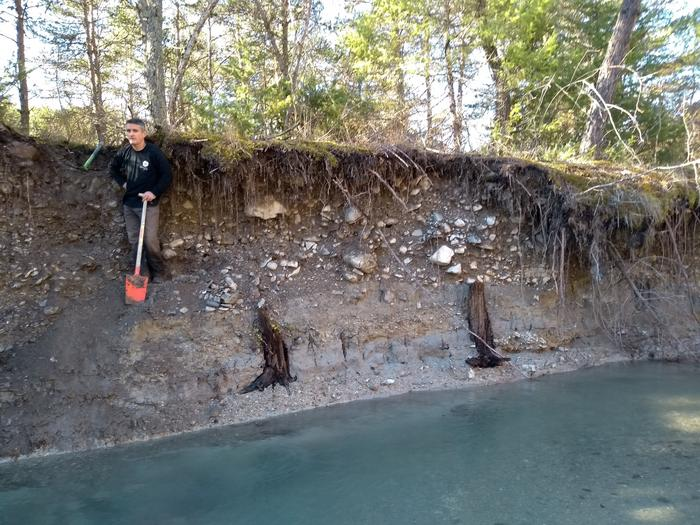Towards the end of the last Ice Age, the Sun experienced a solar storm of staggering power, bombarding the Earth with charged particles that produced a surge in radioactive carbon. Subfossil trees in the French Alps carry the legacy of this event, revealing it as the most powerful of which we can find a record.
The Sun is pretty stormy this year, with more sunspots, solar flares, and coronal mass ejections than any time in the last 20. It’s surprisingly early in what is normally an 11-year cycle for there to be this much activity, raising the possibility next year could be more dramatic still. That’s got solar astronomers recalling great storms of the past, such as the one in 1989 that plunged millions of people into a 9-hour blackout, and the 1859 Carrington Event, which gave electric shocks to telegraph operators.
Given the damage another Carrington Event would do to a society reliant on electricity, it’s important to know how common they are. However, even the Carrington Event may be far from the worst-case scenario. An Anglo-French collaboration has found evidence of something much bigger.
Big solar storms can produce a surge in several radioactive isotopes on Earth, and the bigger they are, the more of these isotopes are produced. Carbon-14 is created when high-energy particles from space collide with nitrogen atoms in the atmosphere, and this gets incorporated into living things. Some of the portion captured by trees is preserved in their trunks, leaving a distinct spike in the layer added in the following year.
Other radioactive elements, such as beryllium-10, don’t leave a biological record, but they can be found in ice deposited in Greenland or Antarctica. We know how fast these isotopes decay, so if we know the timing of the tree ring or ice layer we can work out how many radioactive isotopes there were initially, and therefore the size of the storm.
Living trees only take us back so far. However, researchers examined 140 partially fossilized Scots Pine trunks trapped in the banks of the Drouzet River, and now eroding out. “Finding such a collection of preserved trees was truly exceptional. By comparing the widths of the individual tree rings in the multiple tree trunks, we then carefully pieced together the separate trees to create a longer timeline using a method called dendrochronology,” said Dr Cécile Miramont of Aix-en-Provence University in a statement. Partially fossilized tree trunks are very rarely preserved from glacial periods.

Treetrunks are eroding out of the bank, but sometimes they need help.
Image credit: Cécile Miramont
The team were looking for so-called Miyake Events, the most recent of which occurred in 774 and 993 CE. These dramatic spikes in carbon-14 are usually considered to be marks of powerful solar storms, although some researchers question this, without having a satisfactory alternative explanation.
Six to eight Miyake Events have been suspected prior to this study, the most ancient a little over 9,000 years ago. The incompletely fossilized trees of Drouzet add another event 14,300 years ago.
To confirm this was not some bizarre local event, Miramont and colleagues searched for beryllium-10 in Greenland ice cores, finding a matching immense spike at the same time. It was twice the size of the original Miyake event of 774 CE, and larger than any other that can be found in the record. It would also have been at least 10 times the size of the Carrington Event.

The growth isn’t even but the rings keep the score.
Image credit: Cécile Miramont
Despite other researchers’ doubts, those in this study attribute the radioisotope spikes to solar activity, although the details remain unclear.
The trees capture another event, a century-long spike in carbon-14 starting around 14,000 years ago. Miramont and co-authors attribute this to a period in which the solar wind dipped so much the Earth was exposed to additional cosmic rays, creating a less intense, but much more long-lasting, increase in radioactive isotope production. The timing matches a planetary cooling period known as the Older Dryas.
“Extreme solar storms could have huge impacts on Earth. Such super storms could permanently damage the transformers in our electricity grids, resulting in huge and widespread blackouts lasting month,” Professor Tim Heaton of the University of Leeds said. “They could also result in permanent damage to the satellites that we all rely on for navigation and telecommunication, leaving them unusable. They would also create severe radiation risks to astronauts.”

Not much is left of some of the trees, with many being so eroded they couldn’t be used.
Image credit: Cécile Miramont
It’s possible to harden at least some of our systems so they can handle larger storms. However, a long period of a relatively placid Sun, combined with humanity’s generally slipshod approach to disaster planning, has meant little of this has been done.
“A precise understanding of our past is essential if we want to accurately predict our future and mitigate potential risks,” Heaton said, although planners also need to act on what has been learned.
The study is published in Philosophical Transactions of the Royal Society A.
Source Link: Ancient Tree Rings Reveal The Most Powerful Solar Storm We've Ever Found